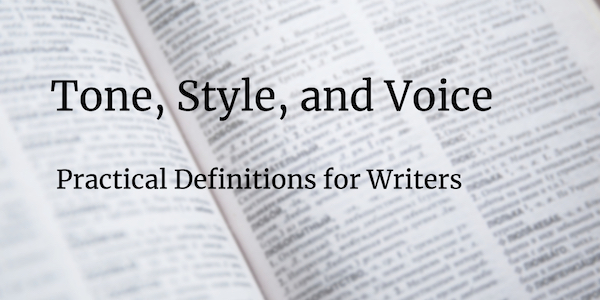 Tone, style, and voice—what do writers mean by those words? Is it worth being accurate and distinguishing between them?
Tone, style, and voice—what do writers mean by those words? Is it worth being accurate and distinguishing between them?
In the past, I’ve tended to use the words together, writing about “tone and style” although they are clearly different things.
So I started looking for more precise definitions.
Merriam-Webster Online is my go-to dictionary when writing, because I don’t have to find the physical dictionary and am less likely to become distracted by adjacent words. (I can spend a lot of time in a dictionary.)
In searching for a decent definition of tone in Merriam-Webster, what do I find? Style.
4 – style or manner of expression in speaking or writing
Okay, then what is style, relevant to writing?
Why not check The Chicago Manual of Style? One sits on my desk, its bright orange cover faded almost white along its spine. In addressing style, it covers writing mechanics and conventions from the structure of a book to the detailed questions of whether the footnote superscript appears inside or outside of punctuation.
It’s got more than a thousand pages:

So, style is all of this?
There are other camps. The book Clear and Simple as the Truth, by Francis-Noël Thomas and Mark Turner, takes as its subject the concept of the classic style of prose. The authors describe this style as an amalgamation of attitude, approach, philosophy, and other attributes. There’s not a single mention of how to format footnotes in it.
Gah.
We Can’t Control What We Don’t Understand
Here’s the problem: this vague overlap makes the whole issue of tone and style seem amorphous and difficult to control. How can I possibly manage tone and style in revision if I don’t even understand what I’m talking about?
For my own peace of mind, I decided to stake out a few practical definitions—ones that we can use in writing and revision.
I started with three simple observations:
- Some part of this equation is instinctive. Without giving it a lot of thought, you adjust your writing style automatically when drafting an email to a friend arranging a weekend dinner versus your manager asking for a raise. Somehow, you understand how to write to create a different effect and feeling.
- Instinct is only the starting point. You can make changes in revision that have a major impact.
- You can’t control everything. People may misinterpret what you write. Ultimately, what matters is what the reader perceives, not what you intend.
So, let’s create definitions that differentiate between what happens automatically in our writing, what others perceive, and what we can control in revision. Here’s my pass.
It begins with the writer’s voice
We think of voice as being something inherent to use. Writers often speak of the challenge of “finding their authentic voice.” And like a speaking voice, we may have distinctive natural writing voices.
Your writing voice originates in the unique way your brain assembles thoughts and words. Just as your loved ones can recognize your spoken voice, your written prose may bear your unmistakable signature—at least in first drafts.
Let’s say that half of the writing voice is inherent to the writer. But we can also inhabit the voices of other people — that’s what the best ghostwriters do. Or, novelists create voices of their characters. Our moods and mindsets definitely color the voice. And, we can easily adapts and change voice in revision.
After writing an entire book on the topic, The Writer’s Voice, I’ve come to the following definition:
The ‘voice’ of a piece is the writer/narrator’s voice as perceived by the reader.
This leaves room for both halves of voice—what happens in the writer’s head, and what the readers encounter in print and recreates in their own minds.
Tone Belongs to the Reader
Let’s use the word tone to refer to the emotion or attitude projected by the writing, including:
- The writer’s attitude toward the subject
- The overall feeling the reader experiences while reading
- The reader’s interpretation of the writer’s attitude toward the reader
Tone is decided during reading, not writing. It’s subjective—what matters is what the reader feels, not what the writer intends.
You may be excited about your topic, but if you ignore the reader’s needs and interests entirely, you may come across as condescending, pedantic, or boring—most likely not the tone you were hoping to achieve.

Style Controls Tone
Style is the amalgamation of writing techniques by which you communicate a desired tone. Style is the part that you can control, often in revision and editing. It includes everything from sentence structure and word choice to grammar conventions (and when to flout them.)
Putting this all together:
Writing voice: Your voice is the starting point, and when writing freely reflects your thought processes. However, you influence voice by imagining the reader when you write and revise, and trying to speak to them comfortably and naturally. Author and writing instructor Jerry Jenkins suggests that voice is “your unique lens through which you see the world.”
The tone is how the readers feel about the writing. Did it seem like a conversation? (See this post for my take on the conversational tone.) Was it hard to read? Was it formal or informal, exciting or dull?
Writing style refers to the means by which you achieve the desired tone and voice. It includes everything from sentence structure and word choice to playing fast and loose with grammar. In a future post I’ll cover some of the ways to influence your tone in style.
What Do You Think?
I recognize that countless people have defined these terms, so my suggestions may be too little, too late. But I find them helpful in my own work, and share them in that spirit.
Let me know what you think in the comments.
Related Resources
Take a deep dive into writing voice with my book/workbook The Writer’s Voice: Techniques for Tuning Your Tone and Style.
For more thoughts on tone, see the post Mind Your Tone of Voice.